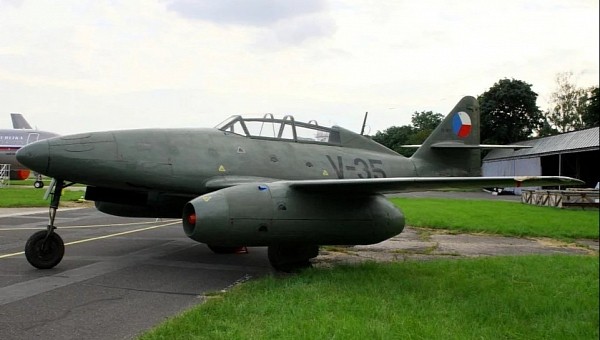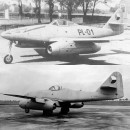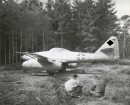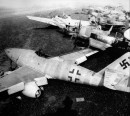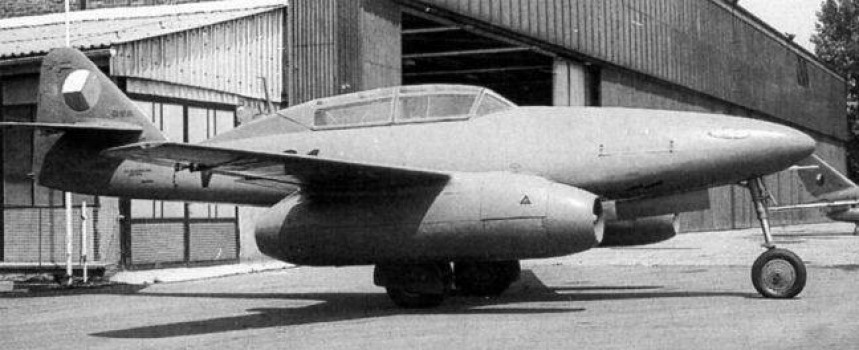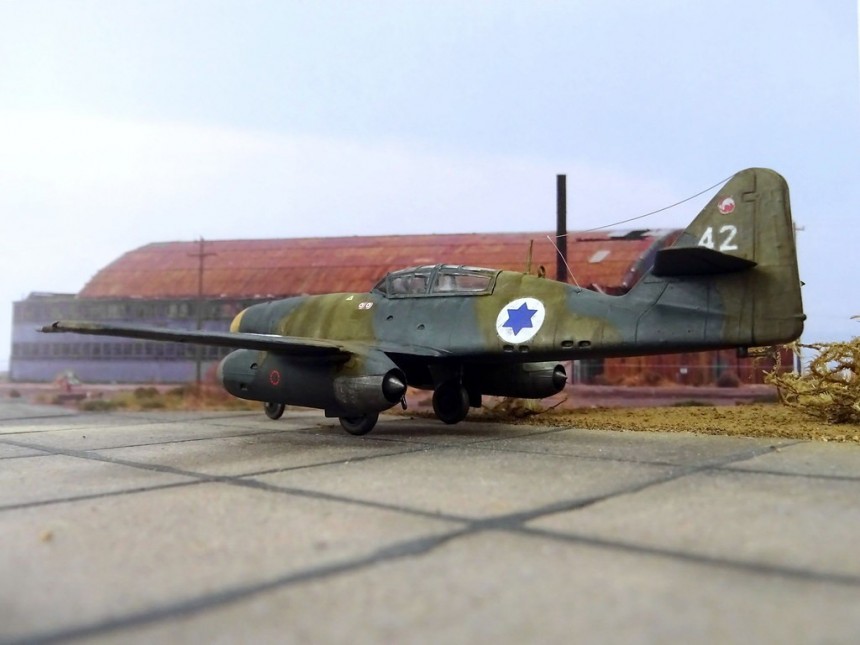By early 1944, it's thought that German military aircraft technology was as much as five to ten years more advanced than anything the Allies had at their disposal at the time. Nowhere was this more apparent than the Messerschmitt Me-262.
The Storm Bird
The Me-262 is a jet that needs no introduction. Perhaps no German WWII fighter on this side of the Bf-109 and possibly the Fokke Wulf Fw-190 is as recognizable as the Me-262 jet. But for how well-known and well-celebrated the world's operational first jet fighter is, its history post-1945 is largely forgotten.
The Me-262 may have been conceived as a Nazi wonder weapon, but its history after the fall of the Third Reich is less cut-and-dry. Those who paid attention in history class need not hear another dissertation about the dog days of World War II. Something along the lines of Hitler getting too big for his britches before Stalingrad and then D-Day put his Wehrmacht in its place.
As grossly oversimplified as that explanation may be, what matters in the case of the Me-262 is the timing. With its deployment date of April 1944, Herman Goering's Luftwaffe had plenty of time to become acquainted with the particulars of novel jet engines. As many as 11 to 12 months before the Second World War's end.
Compared to Allied British and American jet fighters of the era, like the Gloster Meteor and Lockheed Shooting Star, it was clear the extra development time played very much in Messerschmitt's favor. Under the U.S. Army Air Force's Operation Luftwaffe Secret Technology (LUSTY), captured Me-262s remaining intact after Germany's surrender were transported to Wright-Patterson Air Force Base near Dayton, Ohio, where this point was only proven further.
For instance, the wing-slat configuration of the famous North American F-86 Saber looked awfully familiar to that of the German jet. Of course, this feature is by no accident on the part of the Saber. But while the Soviets and Americans busied themselves reverse engineering the Me-262's technology, the Czechoslovakian Military took an altogether different approach, at least at first.
Their answer to post-war jet fighters involved continuing the Me-262's production with factories and tooling left over from the German occupation. The Czechoslovak Avia group manufactured parts of the airframe during the war. By 1945, Avia was even building entire Me-262 airframes in kit form. Doing so using pre-assembled sections of airframes joined together by Czechoslovak laborers. They were some of the last German jets to take to the skies before the capitulation of all Axis forces.
Overlapping with the reformation of the pre-war Czechoslovak State and subsequent adoption of state communism, these Czechoslovak Me-262s looked identical to their Second World War counterparts. Each unit's Junkers Jumo axial-flow turbojet engines were also holdovers from before the fall of the Luftwaffe. The results were nothing short of uncanny.
The type's first test flight took place on August 26th, 1946. At the controls was Avia's chief test pilot, a man by the name of Antonin Krause. Though the S-92 was every bit the hot shot it was as its forbearers, the test airframe crashed the following month. In total, at least 12 Avia S-92 airframes were constructed, using the same four 30-mm cannons as the German Messerschmitt.
Nine were built in the single-seat variant and a further three in the CS-92 two-seater configuration. All S-92s still flying after testing concluded had their Junkers Jumo 004 engines overhauled by in-house Avia engineers and dubbed the M-04. One airframe was trialed with the BMW 003 engine with negative results, switching to the M-04 soon after.
This overhaul is thought to have extended the service life of each engine well past the 30 to 50 flight hours of the German Me-262 up to as many as 60 or more. However, murky record-keeping by post-war communist governments makes this hard to verify. What's even harder to verify is possibly the most historically significant part of the Avia S-92's story. Its alleged, yet unconfirmed, secretive service with the Israeli Air Defense Forces.
The sight of a Messerschmitt bearing the powerful symbol that is the Star of David is one that's no doubt shocking. It's almost unfathomable, given the context of the war. But these deceptively realistic models were created in the spirit of an interesting conspiracy theory shared on model airplane forums and fringe aviation websites. So the story goes, a secret deal was cut between the new Israeli government and the communist state of Czechoslovakia to procure a handful of Avia S-92s.
Bill Nelson's book detailing the earliest days of the IADF deduces how the fledgling Air Force may have wanted the S-92 to be an introductory vehicle to help Israeli pilots understand and become used to jet technology as a whole. Hidden amongst a crate of Czechoslovak Avia S-199 piston fighters, the S-92s were purported to have entered Israel without so much as a peep.
"According to Egyptian and British intelligence, a jet fighter of unknown type exploded in flight inside Israeli airspace during April 1950. The British thought that it might be a de Havilland Vampire of unknown origin, while the Egyptians stated that they had information revealing that the IAF had secretly taken delivery of crated Avia S.92 jets." Nelson's book states. "The Czechs' Russian masters might have approved such a sale in the first half of 1950, and Israel may have felt an urgent need to answer the threat posed by the new Egyptian Meteors, which arrived in October 1949, to buy this, the only jet available to them."
Some on forums, like key.aero, claim the S-92's only air-to-air kill was a single Egyptian C-47 cargo plane. Even then, this single air-to-air kill has yet to be verified by the Egyptians. In truth, Bill Nelson's book appears to be the only source of evidence linking the S-92 with the Israelis. Apart from some truly spectacular and realistic model art, that is.
Whether or not it's legitimate, what this means for our purposes is that the much-anticipated dogfight between the German Messerchmitt 262 and the British Gloster Meteor that never happened in World War II likely didn't occur during the Arab-Israeli conflict either.
By 1951, the Czechoslovakians had finally obtained Soviet-aligned jet fighters like the MiG-15. This allowed the nation to retire their hideously obsolete S-92s. As of 2022, the two remaining Czechoslovak S-92 airframes are on display at museums located in the modern-day Czech Republic.
The Me-262 is a jet that needs no introduction. Perhaps no German WWII fighter on this side of the Bf-109 and possibly the Fokke Wulf Fw-190 is as recognizable as the Me-262 jet. But for how well-known and well-celebrated the world's operational first jet fighter is, its history post-1945 is largely forgotten.
The Me-262 may have been conceived as a Nazi wonder weapon, but its history after the fall of the Third Reich is less cut-and-dry. Those who paid attention in history class need not hear another dissertation about the dog days of World War II. Something along the lines of Hitler getting too big for his britches before Stalingrad and then D-Day put his Wehrmacht in its place.
As grossly oversimplified as that explanation may be, what matters in the case of the Me-262 is the timing. With its deployment date of April 1944, Herman Goering's Luftwaffe had plenty of time to become acquainted with the particulars of novel jet engines. As many as 11 to 12 months before the Second World War's end.
Compared to Allied British and American jet fighters of the era, like the Gloster Meteor and Lockheed Shooting Star, it was clear the extra development time played very much in Messerschmitt's favor. Under the U.S. Army Air Force's Operation Luftwaffe Secret Technology (LUSTY), captured Me-262s remaining intact after Germany's surrender were transported to Wright-Patterson Air Force Base near Dayton, Ohio, where this point was only proven further.
Inspiring Jets For Years to Come
Now the site of the National Museum of the United States Air Force, the base, then called Wright field, housed the Air Technical Intelligence branch of the Army Air Force's Technical Intelligence School led by Colonel Harold E. Watson. If there were any team well equipped enough in the money and brains departments to reverse German engineer technology, no other fit the bill better than 'Watson's Wizzers,' as they were known. In the end, many designs of post-war American, British, and Soviet jets became inspired by the efforts to uncover the true abilities of the Me-262.For instance, the wing-slat configuration of the famous North American F-86 Saber looked awfully familiar to that of the German jet. Of course, this feature is by no accident on the part of the Saber. But while the Soviets and Americans busied themselves reverse engineering the Me-262's technology, the Czechoslovakian Military took an altogether different approach, at least at first.
Their answer to post-war jet fighters involved continuing the Me-262's production with factories and tooling left over from the German occupation. The Czechoslovak Avia group manufactured parts of the airframe during the war. By 1945, Avia was even building entire Me-262 airframes in kit form. Doing so using pre-assembled sections of airframes joined together by Czechoslovak laborers. They were some of the last German jets to take to the skies before the capitulation of all Axis forces.
Overlapping with the reformation of the pre-war Czechoslovak State and subsequent adoption of state communism, these Czechoslovak Me-262s looked identical to their Second World War counterparts. Each unit's Junkers Jumo axial-flow turbojet engines were also holdovers from before the fall of the Luftwaffe. The results were nothing short of uncanny.
Avia S-92: What's Fact and What's Fiction?
It's as if one's mind struggles to comprehend a Messerschmitt 262 in anything other than Luftwaffe green with Luftwaffe roundels. Dubbed the Avia S-92 Turbina (Turbine), the Czechoslovak's entry into the jet age felt like using a video game cheat code to acquire jet-age military planes. In relation to the costly Soviet and American jets of the day, it was at least a time-conscious and price-effective approach on the part of the Czechoslovakians.The type's first test flight took place on August 26th, 1946. At the controls was Avia's chief test pilot, a man by the name of Antonin Krause. Though the S-92 was every bit the hot shot it was as its forbearers, the test airframe crashed the following month. In total, at least 12 Avia S-92 airframes were constructed, using the same four 30-mm cannons as the German Messerschmitt.
Nine were built in the single-seat variant and a further three in the CS-92 two-seater configuration. All S-92s still flying after testing concluded had their Junkers Jumo 004 engines overhauled by in-house Avia engineers and dubbed the M-04. One airframe was trialed with the BMW 003 engine with negative results, switching to the M-04 soon after.
This overhaul is thought to have extended the service life of each engine well past the 30 to 50 flight hours of the German Me-262 up to as many as 60 or more. However, murky record-keeping by post-war communist governments makes this hard to verify. What's even harder to verify is possibly the most historically significant part of the Avia S-92's story. Its alleged, yet unconfirmed, secretive service with the Israeli Air Defense Forces.
Did The Israelis Fly German Jets?
So the story is told in the American author Bill Norton's biography of the IADF, Air War on the Edge; the Israeli response to newly acquired Gloster Meteor British jets by the Egyptians was one they likely wanted to keep quiet. The notion of the Jewish state operating an aircraft even remotely related to the Third Reich by heritage would have been a societal outrage in the newly formed country. Though no mention of any significance has ever been publicized, photographs taken by talented miniature model enthusiasts show what the Avia S-92 would have looked like in IADF markings.The sight of a Messerschmitt bearing the powerful symbol that is the Star of David is one that's no doubt shocking. It's almost unfathomable, given the context of the war. But these deceptively realistic models were created in the spirit of an interesting conspiracy theory shared on model airplane forums and fringe aviation websites. So the story goes, a secret deal was cut between the new Israeli government and the communist state of Czechoslovakia to procure a handful of Avia S-92s.
Bill Nelson's book detailing the earliest days of the IADF deduces how the fledgling Air Force may have wanted the S-92 to be an introductory vehicle to help Israeli pilots understand and become used to jet technology as a whole. Hidden amongst a crate of Czechoslovak Avia S-199 piston fighters, the S-92s were purported to have entered Israel without so much as a peep.
"According to Egyptian and British intelligence, a jet fighter of unknown type exploded in flight inside Israeli airspace during April 1950. The British thought that it might be a de Havilland Vampire of unknown origin, while the Egyptians stated that they had information revealing that the IAF had secretly taken delivery of crated Avia S.92 jets." Nelson's book states. "The Czechs' Russian masters might have approved such a sale in the first half of 1950, and Israel may have felt an urgent need to answer the threat posed by the new Egyptian Meteors, which arrived in October 1949, to buy this, the only jet available to them."
An Interesting Footnote in Aviation History
Admittedly, nowhere in the book does Nelson claim this story is true. Quite the opposite. "The Me 262 was hopelessly antiquated in 1950, and the late Second World War technology was of very limited service life. If the story is true, it is odd that the Israelis would not have admitted to operating the Me 262, no matter how briefly and unsuccessfully, since 1950."Some on forums, like key.aero, claim the S-92's only air-to-air kill was a single Egyptian C-47 cargo plane. Even then, this single air-to-air kill has yet to be verified by the Egyptians. In truth, Bill Nelson's book appears to be the only source of evidence linking the S-92 with the Israelis. Apart from some truly spectacular and realistic model art, that is.
Whether or not it's legitimate, what this means for our purposes is that the much-anticipated dogfight between the German Messerchmitt 262 and the British Gloster Meteor that never happened in World War II likely didn't occur during the Arab-Israeli conflict either.
By 1951, the Czechoslovakians had finally obtained Soviet-aligned jet fighters like the MiG-15. This allowed the nation to retire their hideously obsolete S-92s. As of 2022, the two remaining Czechoslovak S-92 airframes are on display at museums located in the modern-day Czech Republic.
